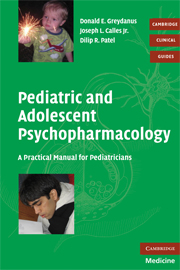Book contents
- Frontmatter
- Contents
- Contributors
- Foreword by Christopher K. Varley
- Foreword by Renée R. Jenkins
- Preface
- Acknowledgement
- 1 Principles of psychological management
- 2 The basics of pharmacology and neurotransmission
- 3 Basics of prescribing psychopharmacologic agents
- 4 Anxiety disorders
- 5 Attention deficit/hyperactivity disorder
- 6 Child and adolescent depression
- 7 Disruptive behavior and aggressive disorders
- 8 Schizophrenia in childhood and adolescence
- 9 Autism spectrum disorders
- 10 Psychotropic management of children and adolescents with cognitive–adaptive disabilities
- 11 Sleep disorders in children and adolescents
- 12 Tic disorders in children and adolescents
- 13 Substance abuse disorders
- Subject index
- References
6 - Child and adolescent depression
Published online by Cambridge University Press: 18 December 2009
- Frontmatter
- Contents
- Contributors
- Foreword by Christopher K. Varley
- Foreword by Renée R. Jenkins
- Preface
- Acknowledgement
- 1 Principles of psychological management
- 2 The basics of pharmacology and neurotransmission
- 3 Basics of prescribing psychopharmacologic agents
- 4 Anxiety disorders
- 5 Attention deficit/hyperactivity disorder
- 6 Child and adolescent depression
- 7 Disruptive behavior and aggressive disorders
- 8 Schizophrenia in childhood and adolescence
- 9 Autism spectrum disorders
- 10 Psychotropic management of children and adolescents with cognitive–adaptive disabilities
- 11 Sleep disorders in children and adolescents
- 12 Tic disorders in children and adolescents
- 13 Substance abuse disorders
- Subject index
- References
Summary
Sadness is one of the basic human emotions, and is usually associated with a current or past tragic event, such as the loss of a loved one. Depression is a more sustained state of sadness (or anger – see below) which can either arise spontaneously or follow disruptive events in the person's life. Untreated, depression can lead to morbidity and mortality, and is a significant risk factor for suicide.
The goal of this chapter is to guide the primary care clinician in the proper selection and management of medications for the treatment of depression in children and adolescents.
Definition
The clinical syndrome of major depressive disorder (MDD) is diagnosed in younger people using the same criteria as those used for adults, with some modifications made for developmental differences. For example, the 2-weeks of near-constant depressed mood can be experienced as irritability or angry mood (rather than sadness) in children and adolescents. Instead of weight loss, children may fail to gain weight appropriately. A particularly meaningful symptom is anhedonia, or the loss of pleasure in usually enjoyable activities; this seems to be fairly specific for depression in younger people. A useful mnemonic to help document the signs and symptoms of MDD is SIGECAPS (Table 6.1).
There are other diagnoses to consider when evaluating a depressed child or adolescent, and those will be described in the section on Differential diagnosis below.
Epidemiology
At any given time before puberty, 1–2% of children will experience a depressive disorder.
- Type
- Chapter
- Information
- Pediatric and Adolescent PsychopharmacologyA Practical Manual for Pediatricians, pp. 103 - 116Publisher: Cambridge University PressPrint publication year: 2008
References
- 1
- Cited by



